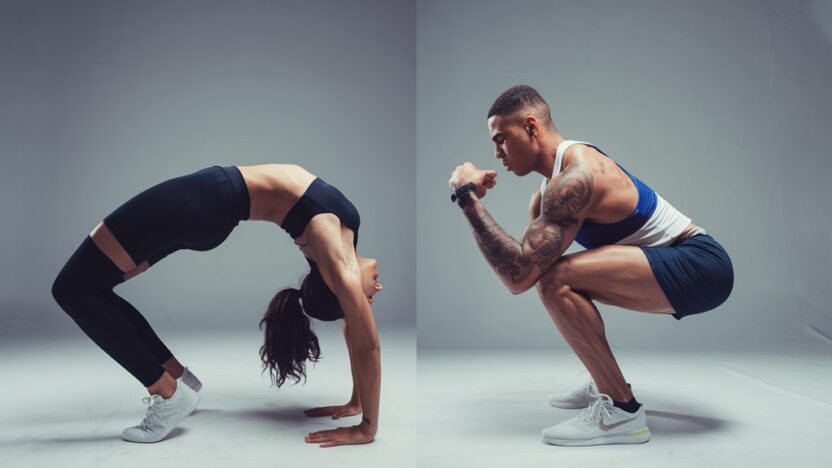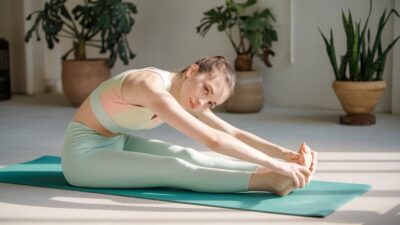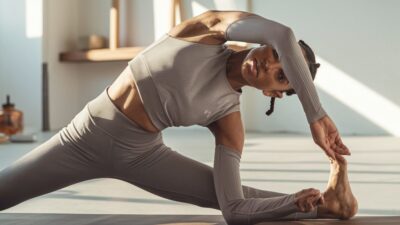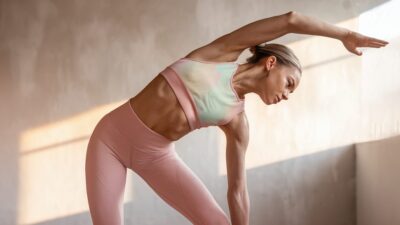While flexibility and mobility are often confused, they serve different but complementary roles in your body's movement. Flexibility refers to your muscles' ability to stretch passively, like when you're reaching for your toes while sitting. Mobility, on the other hand, involves your joints' ability to move actively through their full range of motion, such as when you're doing squats or shoulder circles. You need both qualities for peak physical performance, but they require different training approaches. While flexibility focuses on stretching muscles, mobility work emphasizes controlled movement patterns and joint stability. Understanding these distinctions can transform how you approach your movement practice.
Understanding These Different Movement Qualities

Many people mistakenly use the terms flexibility and mobility interchangeably, but they're actually distinct physical attributes that serve different purposes.
When you're looking at flexibility vs mobility explained, think of flexibility as your body's ability to stretch passively, like when you're reaching for your toes while sitting. Mobility, on the other hand, involves active movement and control through your range of motion, such as performing a deep squat with proper form.
To improve your flexibility, you can incorporate various beginner exercises and techniques that focus on stretching and yoga poses.
The differences between flexibility and mobility become clearer when you understand their practical applications. You might be flexible enough to touch your toes while sitting, but that doesn't mean you can maintain proper form during a forward bend while standing.
That's because mobility requires strength, coordination, and stability along with flexibility. When you're focused on improving flexibility and mobility, you'll need different approaches for each.
Flexibility work might include static stretching and held poses, while mobility training incorporates dynamic movements, controlled exercises, and functional patterns that mirror real-life activities.
Understanding these distinctions will help you develop a more effective movement practice.
Why Flexibility Matters
Developing flexibility plays a fundamental role in both daily life and athletic performance. When you increase your flexibility, you'll notice improvements in your posture, reduced muscle tension, and better range of motion in your joints. This enhanced flexibility directly impacts why mobility matters for fitness, as it allows your body to move more freely through various exercises and daily activities.
In addition, incorporating strength training into your routine can complement your flexibility efforts, leading to stronger muscles that support joint function and overall mobility. By engaging in strength training benefits, you can enhance your body's ability to perform movements with greater ease and efficiency.
You'll find that proper flexibility reduces your risk of injury, especially during workouts or sports activities. When your muscles are flexible, they can lengthen and contract more efficiently, which means you'll experience less strain and fewer pulled muscles. Moreover, flexible muscles help maintain proper joint alignment, making it easier to perform everyday tasks like reaching for objects or bending to tie your shoes.
Your body's flexibility also affects your overall comfort level, as tight muscles can lead to chronic pain and discomfort. By maintaining good flexibility, you're investing in your long-term physical well-being, supporting better circulation, and helping your body recover more quickly from physical activity.
Regular stretching routines can greatly improve your quality of life and athletic performance.
The Role of Joint Mobility

Joint mobility serves as the cornerstone of functional movement, going beyond simple flexibility to encompass how well your joints can move through their complete range of motion. Incorporating targeted flexibility routines can further enhance joint mobility and overall athletic performance.
When you have good joint mobility, you'll find that everyday tasks become easier, from reaching for items on high shelves to bending down to tie your shoes.
Think of your joints as the body's hinges, allowing you to move freely and efficiently in different directions. Unlike flexibility, which focuses mainly on your muscles' ability to stretch, joint mobility involves the coordination of multiple systems, including your muscles, tendons, ligaments, and joint capsules.
You'll notice that when your joints move well, they're able to rotate, glide, and pivot smoothly without restriction or discomfort.
To maintain healthy joint mobility, you'll want to incorporate dynamic movements into your daily routine. This doesn't mean you need to perform complicated exercises; simple activities like arm circles, hip rotations, and ankle rolls can make a significant difference.
Your body will thank you with improved posture, reduced risk of injury, and enhanced athletic performance.
Training Methods and Techniques
The most effective training methods for improving both flexibility and mobility require a balanced approach that combines dynamic stretching, static holds, and movement-based exercises. Incorporating exercises that enhance flexibility and mobility not only aids in injury prevention but also improves overall functional movement, particularly for women boost flexibility and mobility.
You'll want to incorporate a variety of techniques into your routine, ensuring you're addressing both components of your physical fitness.
When you're working on improving your flexibility and mobility, focus on these key training methods:
- Dynamic warm-ups that include arm circles, leg swings, and hip rotations, which prepare your body for more intense movement while gradually increasing your range of motion.
- Controlled mobility drills, such as cat-cow stretches and thoracic spine rotations, that help you develop better joint control and stability.
- End-range exercises that challenge your current limitations through progressive loading and time under tension.
You'll find that combining these methods creates a thorough approach to enhancing your body's capabilities.
Remember to start slowly and progress gradually, as rushing into advanced techniques can lead to injury. It's crucial to maintain proper form throughout each exercise, focusing on quality movement rather than pushing too far beyond your current abilities.
Common Assessment Tests
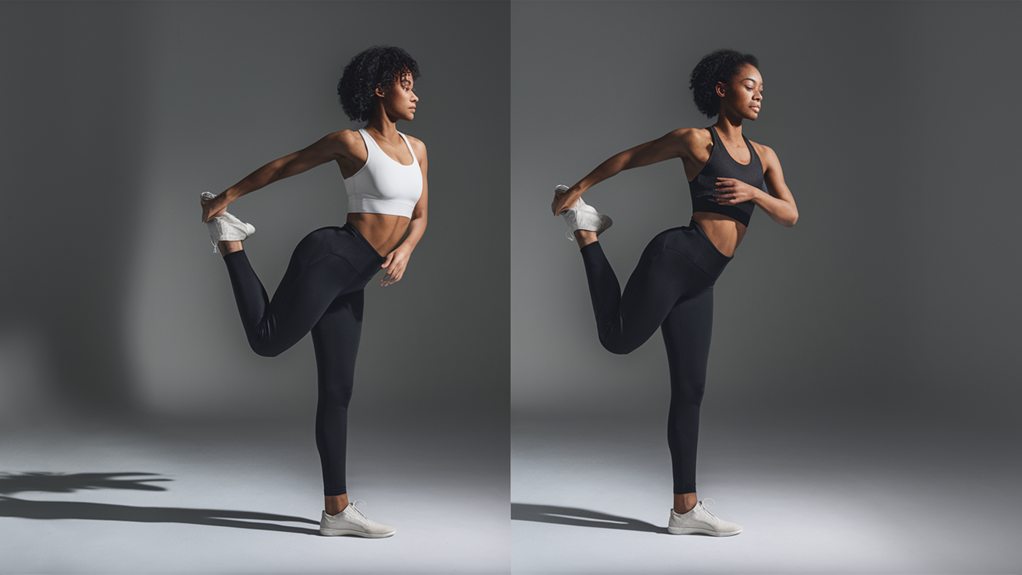
Reliable assessment tests provide essential data points for measuring both flexibility and mobility levels. You'll find that most fitness professionals use a combination of standardized tests to evaluate your current condition and track improvements over time.
It's also important to guarantee that you're practicing these assessments with proper form to avoid injury, as essential safety tips can help you remain injury-free during your evaluations. The sit-and-reach test, for example, helps measure your hamstring and lower back flexibility, while the overhead squat assessment reveals your overall mobility patterns.
For upper body assessment, you'll want to try the shoulder mobility test, where you'll reach one arm up and over while the other reaches up from below, attempting to touch your hands behind your back.
The Thomas test, which you'll perform lying on your back, helps evaluate your hip flexor mobility, and the ankle dorsiflexion test measures how well your ankles move through their range of motion.
Don't forget about dynamic assessments like the walking lunge test, which shows how well you're moving through multiple joint patterns.
You can also use the active straight leg raise test to check both flexibility and mobility in your posterior chain, including your hamstrings and lower back.
Building Your Movement Practice
Building Your Movement Practice
Beyond assessment tests, developing a consistent movement practice requires a thoughtful and systematic approach. You'll want to start by creating a plan that works with your schedule, abilities, and goals, making sure it's something you can stick to long-term.
Incorporating functional fitness routines can enhance your movement practice by utilizing available equipment effectively. Building a successful practice isn't just about following random exercises; it's about creating a structured routine that progresses naturally.
To build an effective movement practice, focus on these key elements:
- Start with a proper warm-up that includes dynamic stretches, joint mobility work, and light cardiovascular activity to prepare your body for movement.
- Include a mix of flexibility and mobility exercises, targeting different muscle groups and movement patterns throughout your weekly routine.
- Progress gradually by increasing duration, intensity, or complexity of movements only when you've mastered the current level.
